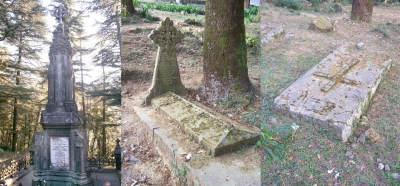Spotlight on Raj cemeteries revives graveyard tourism talk in Himachal
VISHAL GULATI

Shimla, May 21 (IANS) Colonial-era cemeteries in Himalayan hill stations of Himachal Pradesh, with the oldest grave dating back to 1828, are a matter of grave concern now -- a fading heritage of the Raj.
The reason: Local authorities, it seems, are burying its heritage, along with the dead.
Many of the British-era cemeteries dotted across the state are testimony to a history. But they have fallen into a sad state of desolation and disrepair. They have simply turned into heaps of garbage lying where flowers used to bloom once. Also they are a haven for tipplers and marijuana smokers.
Officials admit the cemeteries are literally in shambles with graves simply vanished and the left-over ones with faded epitaphs and damaged tombstones are beyond recognition. The encroachers have gobbled up the gravestones.
With graveyard tourism plan remaining buried deep, local residents rue many foreigners, for whom visiting the cemetery in Shimla is like a pilgrimage, leave the place with a very heavy heart by often verbal remarking, "Is this the way the local administration treats those who died serving the British?"
More than 75 years after the British left, most of the Himalayan town still attracts thousands of domestic and overseas tourists. Many of the foreign tourists are descendants of Englishmen, who lived here during the British rule.
The government was, in fact, once planning to promote graveyard tourism.
The Oakover cemetery, the oldest British-era cemetery in this erstwhile summer capital that lies adjacent to the Chief Minister's official residence, is a picture of neglect with faded epitaphs, damaged tombstones and moss-covered graves.
Opened in 1828, the last grave was of Captain Mathew William Ford, which dates back to March 17, 1841.
Shimla, the summer capital of British India between 1864 and 1939, still boasts of a few British timbered structures from the Ellerslie to the Christ Church on the Ridge to the Viceregal Lodge and the elegant Wildflower Hall.
But the government's plans to make the cemeteries a place of tourist interest have apparently been given a silent burial, remarked Shimla-based hotelier D.P. Bhatia, who believes the graveyard tourism can act as a catalyst for those in search for unique memories of their buried relatives.
"Initially, the idea of graveyard tourism seemed ghoulish. But for the Englishmen, whose kith and kin are buried in Shimla or elsewhere, visiting a grave is like visiting a relative," Bhatia, who has been in the hotel industry for nearly four decades, told IANS.
Besides Shimla, many other hill destinations in the state have cemeteries and churches are in thickly wooded hills of McLeodganj, where Lord Elgin, Viceroy and Governor-General of India, buried died in 1863, Kasauli, Dalhousie, Dharampur, Dagshai and Subathu, to name a few British settlements.
Upset over knowing the cemetery in McLeodganj in Kangra district is in tatters and local authorities have no burial record, an elderly couple from London wrote to this correspondent after nearly a year-long wait, "Now that we know the church officials are unable to give us much help, I am sorry to say that Ann has reluctantly decided that she does not wish to pursue this matter anymore.
"We have now reached an age when we feel we should spend more time looking forward and less time about our past history."
The book, "The Churches and Christian Cemeteries of Himachal Pradesh", published by the Tourism Department, chronicles details about memorials. There is a memorial to Penelope Chetwode at Khanag near Ani in Kullu district.
Penelope was the daughter of Field Marshal Baron Philip Chetwode, who had served as commander-in-chief of the Indian Army (1930-35).
Another one of the oldest burial grounds in the state is at Subathu, about 65 km from the state capital. It houses most of the graves of British army officers and men who were killed during the war with the Gurkhas in 1814.
Before making the 'Queen of Hills' -- the moniker given to Shimla by the British colonial rulers, its summer capital, the British established cantonments in Subathu, Kasauli and Dagshai in Solan district.
Expressing its anguish, the Himachal Pradesh High Court last week rapped state authorities on their knuckles for "killing heritage".
The high court has directed the government heritage committee to conduct a joint inspection of the British-era cemetery at Kanlog in Shimla with its earlier graves dating back to 1850 and file a status report with regard to violation of the interim development plan.
"The committee shall also point out the violations, if any, of the Ancient Monuments and Archaeological Sites and Remains Act, 1958," observed the division bench of Justices Tarlok Singh Chauhan and Virender Singh.
They passed this order on a petition of local residents alleging the destruction of the revered Kanlog Cemetery.
The petitioners have alleged that they are deeply disturbed by the ongoing devastation of the sacred location. They contended that the cemetery is one of the oldest cemeteries in the country.
"This final resting place of both Christians and Parsis has immense national significance and holds the memories of numerous important individuals throughout history."
According to the petitioners, the cemetery was intended to be preserved and maintained as a prime heritage and historical site.
However, instead of honouring its historical value, the cemetery has fallen victim to unauthorised activities in recent years.
It has been further alleged that a pastor and his trust assumed the responsibility of cemetery's maintenance but private interests have taken precedence over preservation efforts.
The Secretary of the District Legal Services Authority has been directed to visit the site and ensure due compliance of the orders of the high court and submit a status report before the next date of hearing on May 31.